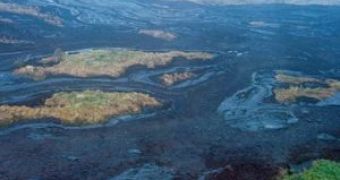Methane, a greenhouse effect gas, saw a rise in the atmosphere during the 1980s, after which, the level of the gas stabilized in the 1990s, providing a bright spot in the growing global warming.
Since 1999, sources of methane from human activities have increased, but their effect on the atmosphere has been counteracted over the same period by a reduction in wetland emissions of methane as they dried out or were drained, especially in the Northern Hemisphere.
"Prolonged drying of wetlands - caused by draining and climate change - has resulted in a reduction in the amount of methane released by wetlands, masking the rise in emissions from human activities" said Dr Paul Steele from CSIRO Marine and Atmospheric Research.
"Had it not been for this reduction in methane emissions from wetlands, atmospheric levels of methane would most likely have continued rising," he says.
"This suggests that, if the drying trend is reversed and emissions from wetlands return to normal, atmospheric methane levels may increase again, worsening the problem of climate change."
"It's important to know if methane is going to stabilize or to increase again, because methane is about 20 times more efficient [at trapping heat] in the atmosphere than CO2 [carbon dioxide, another greenhouse gas]," said Philippe Bousquet, a physicist and chemist at the University of Versailles and the Laboratory of the Sciences of the Climate and the Environment in Gif-sur-Yvette, France.
The researchers used computer simulations of how the gas is transported in the atmosphere to find the source of methane emissions, based on the past 20 years of atmospheric measurements.
The results indicate that a reduction and/or more efficient use of natural gas in the Northern Hemisphere was largely responsible for the drop in methane emissions in the 1990s.
Slow growth in methane emissions during the 1990s may have been triggered, in part, by the industrial collapse of the former Soviet Union and efforts to reduce landfill methane emissions in North American and Europe.
Also, improved piping of natural gas and the capture of methane from landfill sites to generate electricity may have played their role.
The recent rise starting with 1999 coincides with China's economic boom and that country's growing fossil fuel consumption.
But Bousquet said his study "cannot constitute a proof, but [it] urges [others] to perform direct of estimates emissions in Asia."
Also the melting of permafrost due to global warming increases the methane emissions from wetlands in northern latitudes.
Since preindustrial times, the amount of methane in Earth's atmosphere has nearly tripled.
About a third of methane emissions come from natural sources (wetlands, forest and grass fires, oceans, and others).
Methane is the second most important greenhouse gas after carbon dioxide and is estimated to have been responsible for a fifth of the enhanced greenhouse effect over the past 200 years.
The remaining two-thirds reportedly come from human sources (the production and transportation of oil and natural gas, coal mining, rotting landfills, sewage, livestock ruminants produce huge amounts of methane in their stomachs, and others).
Ultraviolet radiation remove more than 90 percent of the emitted methane in the atmosphere.
"It will be very difficult to control carbon dioxide in the short-term future. Not only because of energy [consumption] and political consequences but also because the lifetime of carbon dioxide is enormously long," said Jos Lelieveld, an atmospheric chemist at the Max Planck Institute for Chemistry in Mainz, Germany.
"And so if climate change is really affecting our daily lives in a really undesirable way-like stronger hurricanes or more droughts in some areas-then there may be the desire to do something on the short term," Lelieveld added.
"One of the few alternatives that we have there is to reduce methane," he said.
Methane from fossil fuels is cost-effectively captured and burned to produce electricity and carbon dioxide.
Producing carbon dioxide may be the lesser of two evils, because it is much weaker than methane in trapping heat.

 14 DAY TRIAL //
14 DAY TRIAL //